From Game to Concert: Exploratory Listening in ‘Stardew Valley: Festival of Seasons’ Concert Tour
Abstract
1. Introduction
2. Materials and Methods
2.1. Participants
2.2. Materials
3. Results
3.1. Musical Familiarity
3.2. Immersion
3.3. Comparing Musical Interpretations
3.4. Patterns of Thought
3.5. Relation of Immersion and Number of Thought Types
3.6. Correlation Between Different Thought Types
3.7. Relation of Immersion and Specific Thought Types
4. Discussion
Supplementary Materials
Author Contributions
Funding
Institutional Review Board Statement
Informed Consent Statement
Data Availability Statement
Acknowledgments
Conflicts of Interest
References
- Brandt, J. (2024, November 21). Dates announced for second “Stardew Valley” concert tour, Symphony of Seasons. CBS Philadelphia. Available online: https://www.cbsnews.com/philadelphia/news/stardew-valley-concert-tour-symphony-of-seasons/ (accessed on 1 February 2025).
- Cohen, A. J. (2015). Congruence-association model and experiments in film music: Toward interdisciplinary collaboration. Music and the Moving Image, 8(2), 5–24. [Google Scholar] [CrossRef]
- ConcernedApe. (2016). Stardew Valley (v.1.6.15). ConcernedApe.
- Cook, N. (2004). Analysing musical multimedia. Oxford University Press. [Google Scholar]
- Curran, N. (2018). Factors of immersion. In The Wiley handbook of human computer interaction (pp. 239–254). John Wiley & Sons, Ltd. [Google Scholar] [CrossRef]
- Greenfield-Casas, S. (2023). From the screen (to the screen) to the Concert Hall: Arrangement as a world-building and world-bridging device in the Kingdom Hearts series. In R. Banagale (Ed.), The Oxford handbook of arrangement studies. Oxford University Press. [Google Scholar] [CrossRef]
- Haywood, N., & Cairns, P. (2006). Engagement with an interactive museum exhibit. In T. McEwan, J. Gulliksen, & D. Benyon (Eds.), People and computers XIX—The bigger picture (pp. 113–129). Springer. [Google Scholar] [CrossRef]
- Hunt, E. (2024). Video games live and the gamification of the orchestral concert experience. In W. Gibbons, & M. Grimshaw-Aagaard (Eds.), The Oxford handbook of video game music and sound (pp. 648–661). Oxford University Press. [Google Scholar] [CrossRef]
- Jakubowski, K., Margulis, E. H., & Taruffi, L. (2024). Music-evoked thoughts. Music Perception: An Interdisciplinary Journal, 42(1), 3–18. [Google Scholar] [CrossRef]
- Jennett, C., Cox, A. L., Cairns, P., Dhoparee, S., Epps, A., Tijs, T., & Walton, A. (2008). Measuring and defining the experience of immersion in games. International Journal of Human-Computer Studies, 66(9), 641–661. [Google Scholar] [CrossRef]
- Korsgaard, M. B. (2017). Music video after MTV: Audiovisual studies, new media, and popular music (1st ed.). Routledge. [Google Scholar] [CrossRef]
- Kreuzer, M., Wald-Fuhrmann, M., Weining, C., Tröndle, M., & Egermann, H. (2025). Western classical music concerts are more immersive, intellectually stimulating, and social, when experienced live rather than in a digital stream. An ecologically valid concert study on different modes of liveness. Music & Science, 8, 1–13. [Google Scholar] [CrossRef]
- Lehman, F. (2013). Hollywood cadences: Music and the structure of cinematic expectation. Music Theory Online, 19(4). Available online: https://www.mtosmt.org/issues/mto.13.19.4/mto.13.19.4.lehman.html (accessed on 1 February 2025).
- Lessiter, J., Freeman, J., Keogh, E., & Davidoff, J. (2001). A cross-media presence questionnaire: The ITC-sense of presence inventory. PRESENCE: Teleoperators & Virtual Environments, 10(3), 282–297. [Google Scholar] [CrossRef]
- Margulis, E. H., Miller, N., Mitchell, N., Windholz, M. O., Williams, J., & McAuley, J. D. (2022a). Intersubjectivity and shared dynamic structure in narrative imaginings to music. Music Theory Online, 28(4). Available online: https://mtosmt.org/issues/mto.22.28.4/mto.22.28.4.margulis.html (accessed on 1 February 2025). [CrossRef]
- Margulis, E. H., Wong, P. C. M., Turnbull, C., Kubit, B. M., & McAuley, J. D. (2022b). Narratives imagined in response to instrumental music reveal culture-bounded intersubjectivity. Proceedings of the National Academy of Sciences, 119(4), e2110406119. [Google Scholar] [CrossRef] [PubMed]
- McAuley, J. D., Wong, P. C. M., Bellaiche, L., & Margulis, E. H. (2021). What drives narrative engagement with music? Music Perception, 38(5), 509–521. [Google Scholar] [CrossRef]
- Okazaki, B. M. (2020). Liveness, music, media: The case of the cine-concert. Music and the Moving Image, 13(2), 3–24. [Google Scholar]
- Omigie, D., & Mencke, I. (2024). A model of time-varying music engagement. Philosophical Transactions of the Royal Society B: Biological Sciences, 379(1895), 20220421. [Google Scholar] [CrossRef]
- Pianzola, F., Riva, G., Kukkonen, K., & Mantovani, F. (2021). Presence, flow, and narrative absorption: An interdisciplinary theoretical exploration with a new spatiotemporal integrated model based on predictive processing. Open Research Europe, 1, 28. [Google Scholar] [CrossRef] [PubMed]
- Reybrouck, M., Podlipniak, P., & Welch, D. (2024). Music listening as exploratory behavior: From dispositional reactions to epistemic interactions with the Sonic World. Behavioral Sciences, 14(9), 825. [Google Scholar] [CrossRef]
- Sekar, S. (2022). Film-with-Live-Orchestra concerts: A new hope. [in]Transition, 9(1), 1. [Google Scholar] [CrossRef]
- Silge, J., & Robinson, D. (2016). Tidytext: Text mining and analysis using tidy data principles in R. Journal of Open Source Software, 1(3), 37. [Google Scholar] [CrossRef]
- SOHO Live. (2024). Stardew valley: Festival of seasons [Concert tour]. Available online: https://www.stardewvalleyconcert.com/festival-of-seasons (accessed on 28 February 2025).
- Swarbrick, D., Martin, R., Høffding, S., Nielsen, N., & Vuoskoski, J. K. (2024). Audience musical absorption: Exploring attention and affect in the live concert setting. Music & Science, 7, 1–19. [Google Scholar] [CrossRef]
- Tan, S.-L., Cohen, A. J., Lipscomb, S. D., & Kendall, R. A. (Eds.). (2013). The psychology of music in multimedia. Oxford University Press. [Google Scholar]
- Tukachinsky, R. (2014). Experimental manipulation of psychological involvement with media. Communication Methods and Measures, 8(1), 1–33. [Google Scholar] [CrossRef]
- van der Walle, H., Wu, W., Margulis, E. H., & Jakubowski, K. (in press). Thoughtscapes in music: An examination of thought types occurring during music listening across 17 genres. Music Psychology. [Google Scholar]
- Vernallis, C. (2013). Unruly media: YouTube, music video, and the new digital cinema. Oxford University Press. [Google Scholar]
- Vroegh, T. (2024). Visual imagery in the listener’s mind: A network analysis of absorbed consciousness. Psychology of Consciousness: Theory, Research, and Practice, 11(1), 46–70. [Google Scholar] [CrossRef]
- Wald-Fuhrmann, M., Egermann, H., Czepiel, A., O’Neill, K., Weining, C., Meier, D., Tschacher, W., Uhde, F., Toelle, J., & Tröndle, M. (2021). Music listening in classical concerts: Theory, literature review, and research program. Frontiers in Psychology, 12, 638783. [Google Scholar] [CrossRef]
- Weining, C. (2022). Listening modes in concerts. Music Perception, 40(2), 112–134. [Google Scholar] [CrossRef]
- Weining, C., Meier, D., Wald-Fuhrmann, M., & Tröndle, M. (2025). From structural listening to daydreaming: Listening modes influence the individual experience in live concerts. Psychology of Music, 1–19. [Google Scholar] [CrossRef]
- White, S. (2018, March 20). Valley forged: How one man made the indie video game sensation Stardew Valley. GQ. Available online: https://www.gq.com/story/stardew-valley-eric-barone-profile (accessed on 1 February 2025).
- Witmer, B. G., & Singer, M. J. (1998). Measuring presence in virtual environments: A presence questionnaire. Presence: Teleoperators and Virtual Environments, 7(3), 225–240. [Google Scholar] [CrossRef]

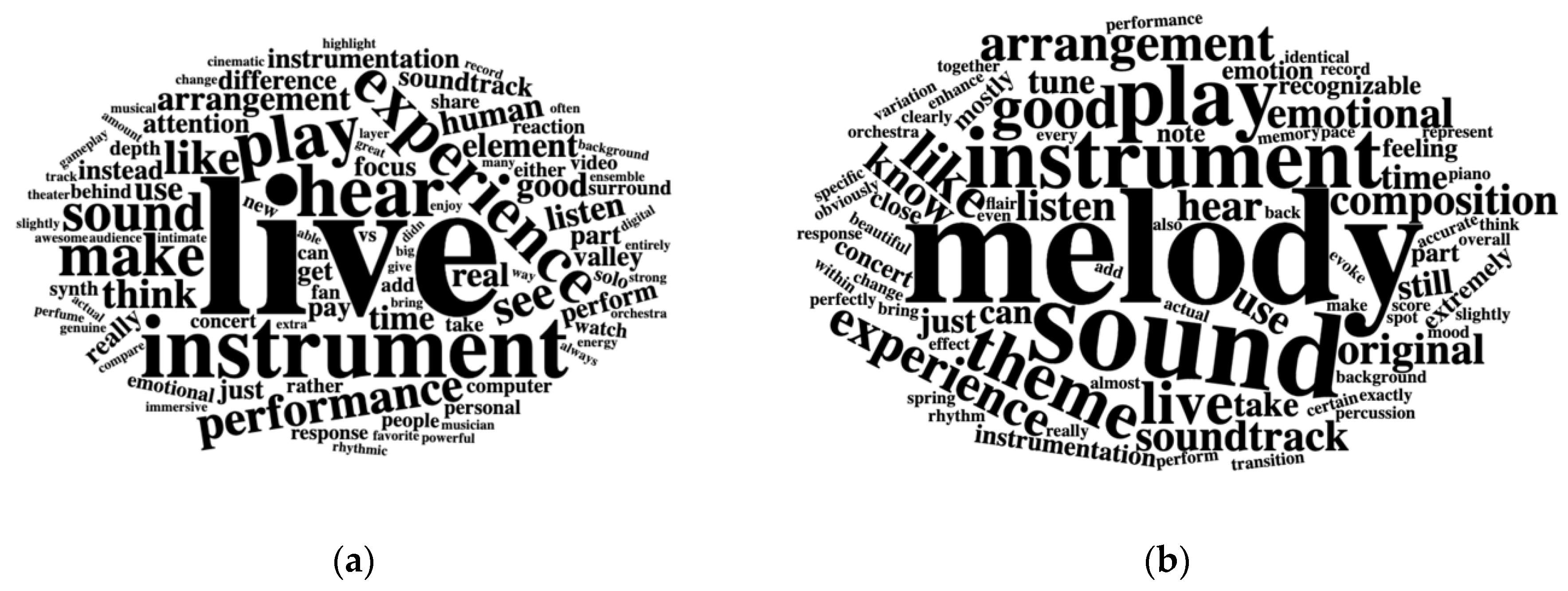

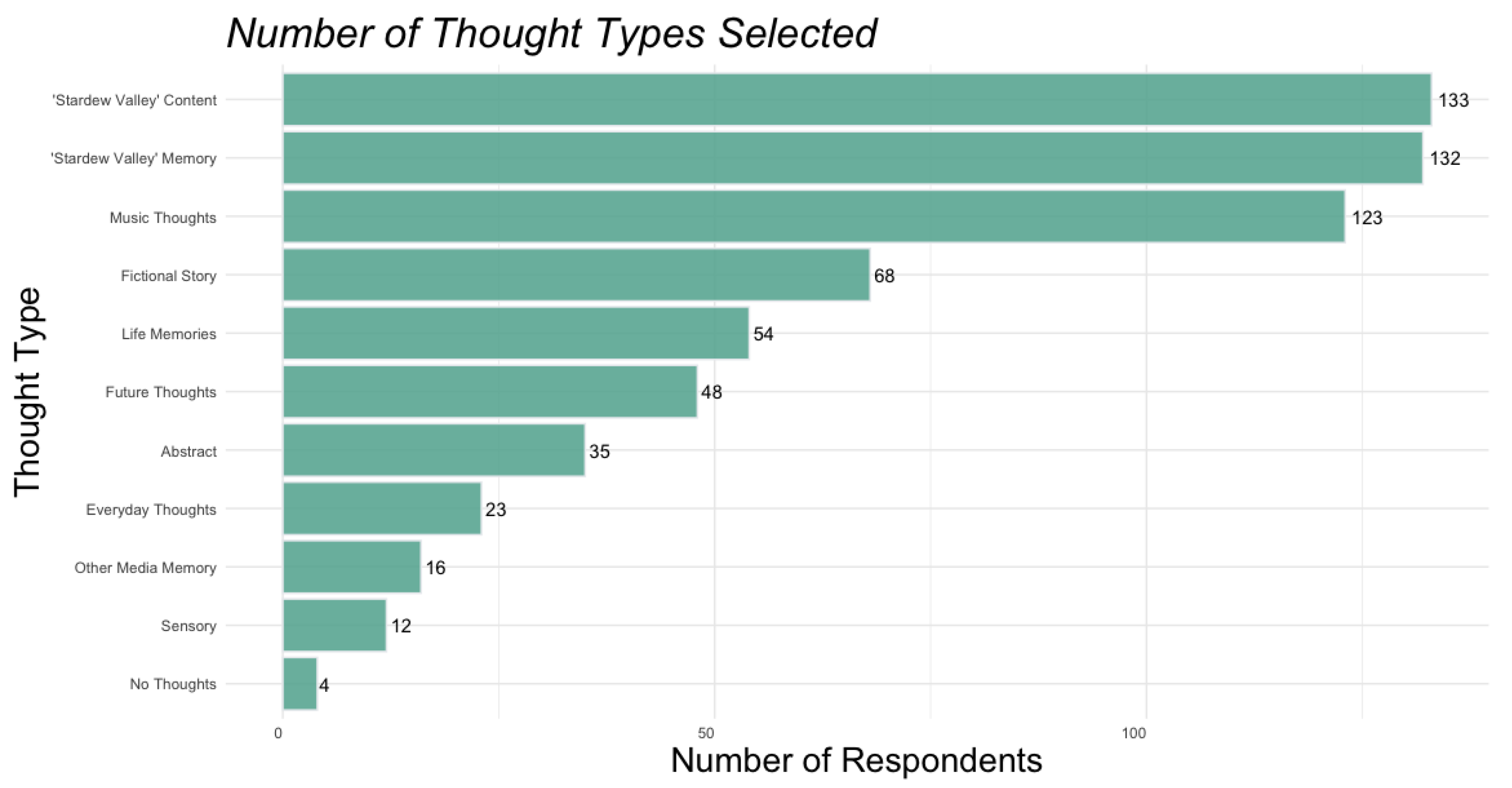
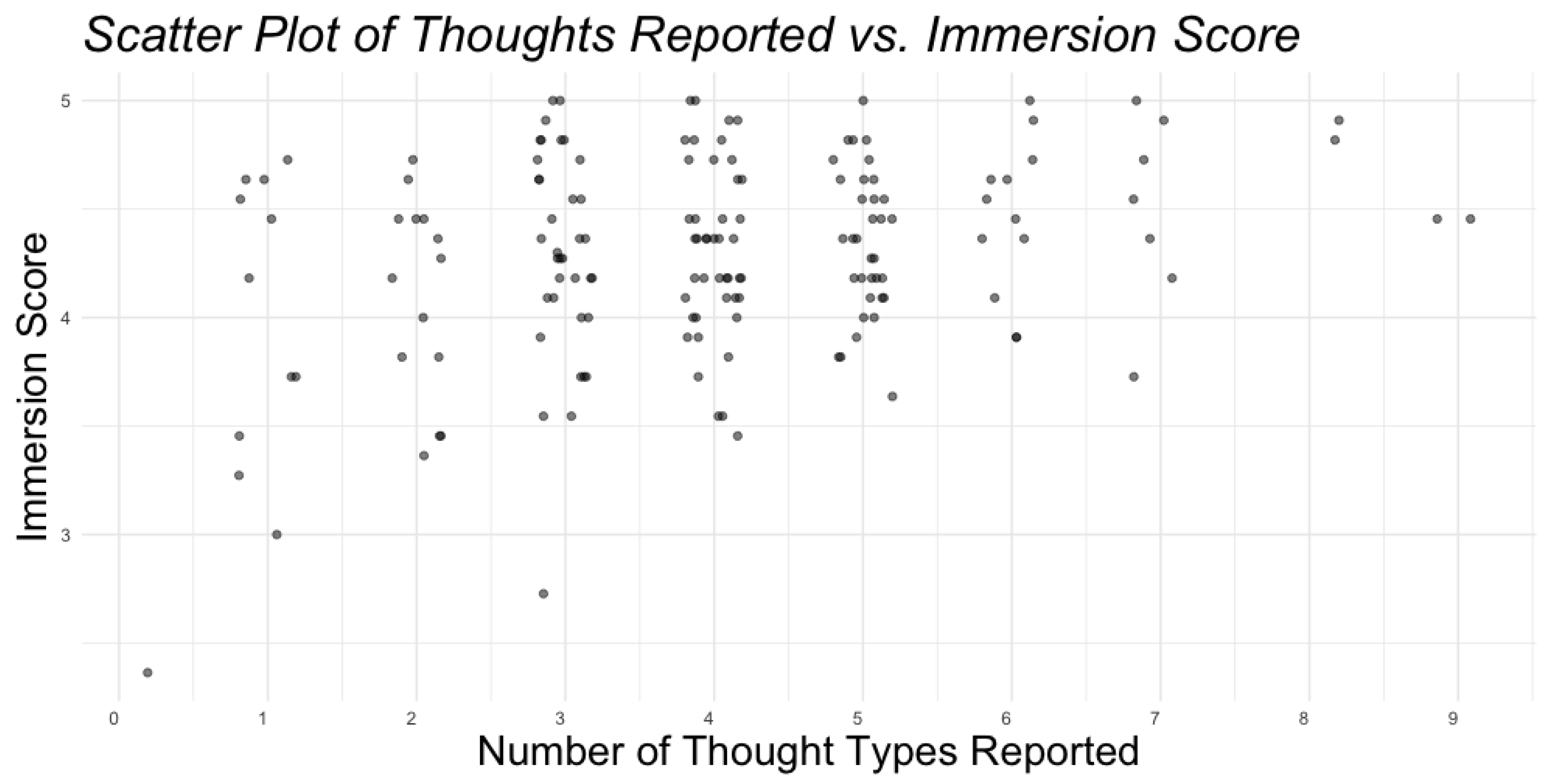
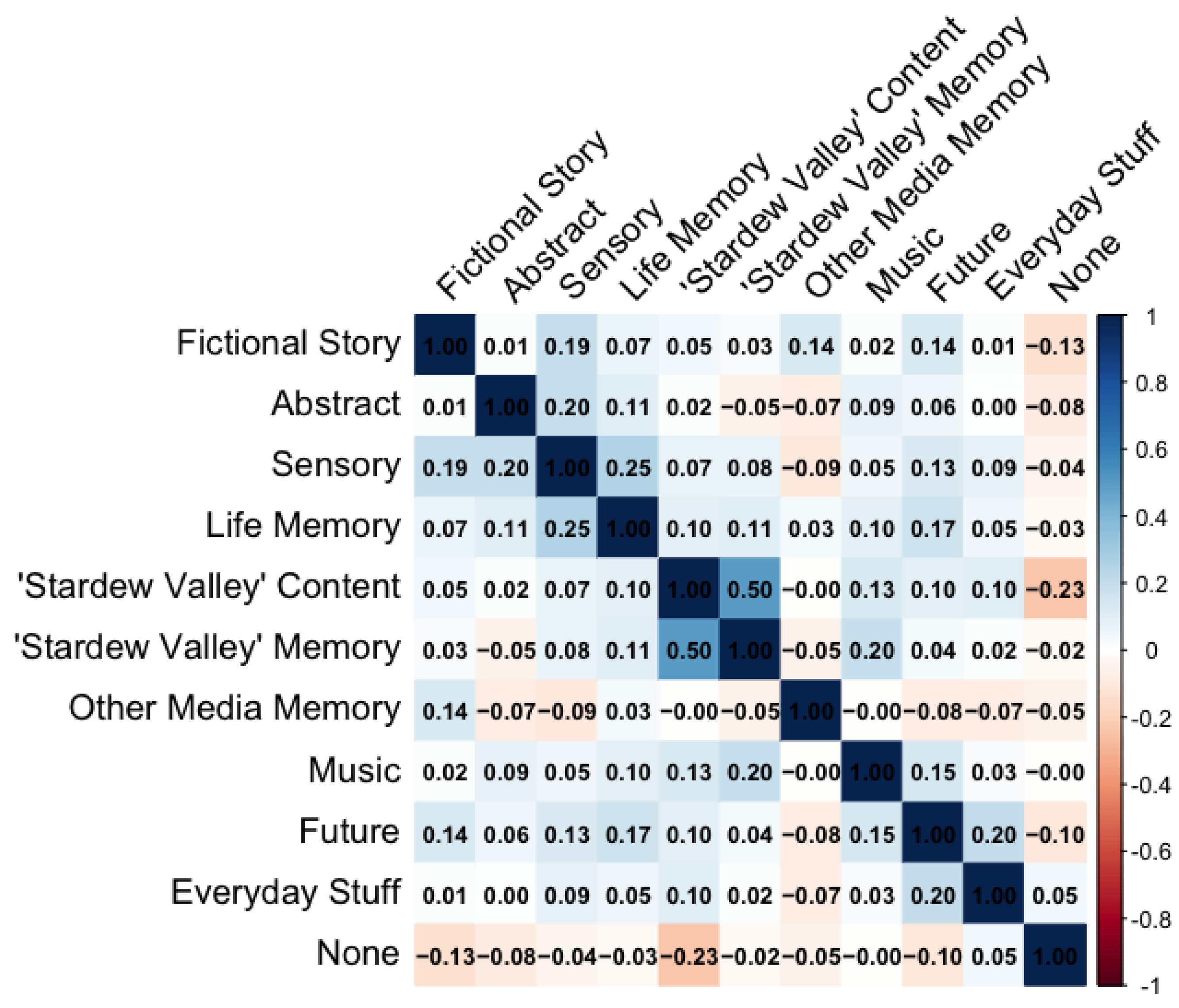
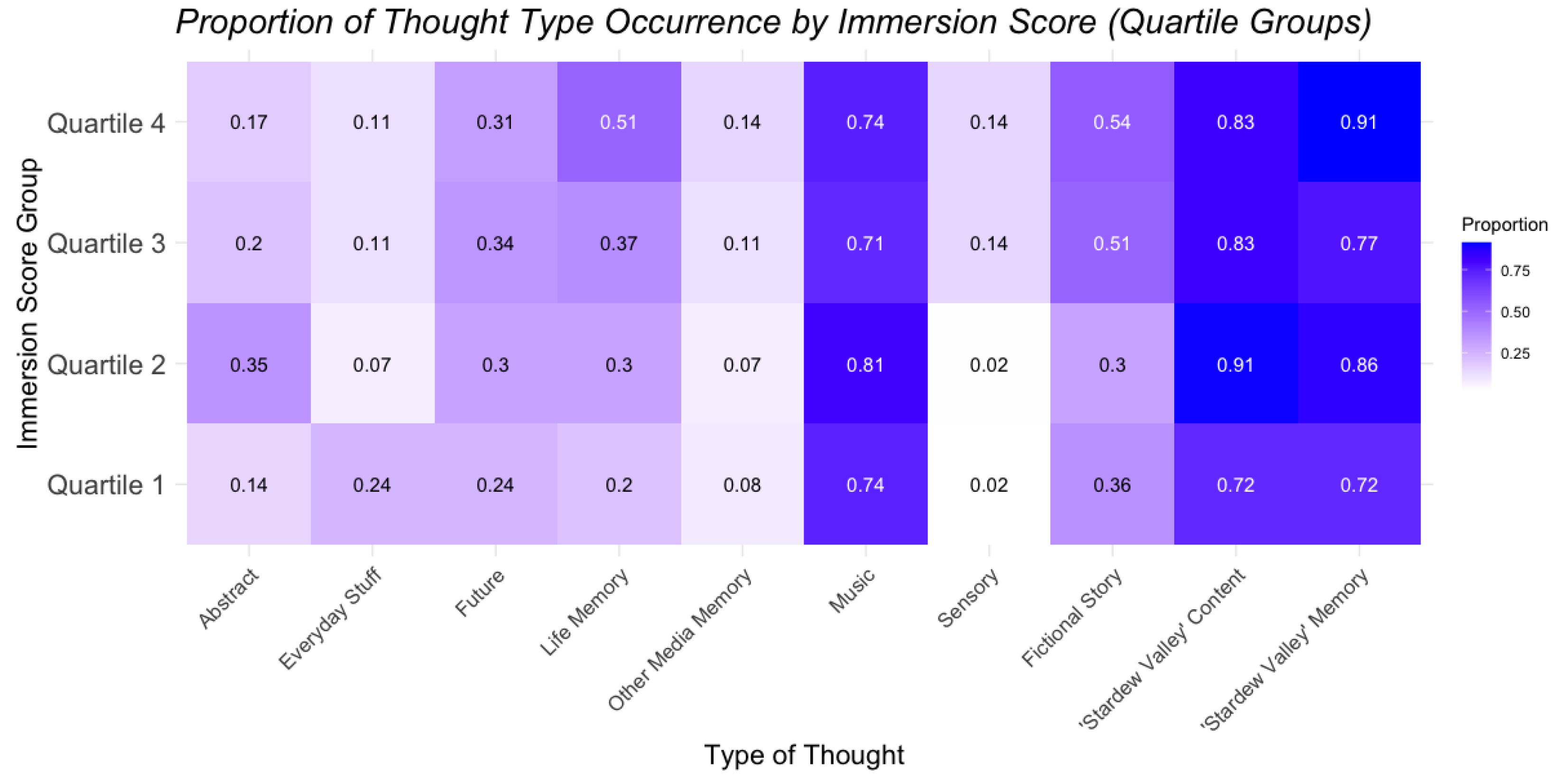
| Thought Type Selection Options |
|---|
| I imagined a fictional story or scene. |
| I imagined abstract shapes, colours, and/or patterns. |
| I imagined smells, tastes, and/or other sensory sensations. |
| I recalled memories of experiences from my life. |
| I recalled specific scenes, images, or gameplay from “Stardew Valley”. |
| I recalled memories from playing “Stardew Valley”. |
| I had thoughts about the music. |
| I had thoughts about the future or personal plans. |
| I was thinking about everyday stuff. |
| Other (please describe below): |
| Quotes From Respondents Describing Immersion |
|---|
| The arrangements brought depth that took me outside of the seat in the theater. I was transported and felt extremely happy! |
| The music took me right to the outdoors in cool breezes of spring, warm days of summer, cozy fall afternoons, and chilly winter nights, perfectly represented by a little pixilated world. |
| It felt more beautiful and intimate. The music was more in-depth and I felt like I was really there. |
| The concert elevated the music from background soft music to a full out of body experience. The orchestra completely transformed the experience into an immersive emotional experience. |
| It felt more powerful in-person with live music, and it was the only thing I was paying attention to instead of having it in the background |
| While playing the game, I felt the music mainly become a background element as I focused more on what I was doing in game. While sitting in the theater, specifically for the music, I felt much more engaged in the music. |
| I paid more attention to the details of the arrangement and how they adapted it to live performance |
| it felt more cinematic! when I’m playing the game, I’m not paying attention so much to the music either |
| Selected Difference Responses Containing Largest TF-IDF Terms |
|---|
| The music in a concert setting felt more like a collective experience (e.g., audience interactions, reactions, etc.) than when I listen to the music on my own. It was fun seeing my personal reactions and feelings mirrored among hundreds of people. It was awesome! It added an extra layer of love for the music of Stardew Valley that I’ll cherish forever. |
| More personal, more imaginative, more experienced. |
| The fact that it was being perfumed live and that everyone else in the room shared the same experience with this game |
| The live human element of it all |
| I paid more attention to the details of the arrangement and how they adapted it to live performance |
| Getting to hear live instruments is very different from listening to synthesizers on the computer or from a game console |
| The richness of the orchestral instruments! And the human-ness! So good. It brought the score alive. |
| Volume, frequency and vibrations from the analog instruments produces a more physical reaction than the emotional response of the digital video game soundtrack. |
| The atmosphere and the sound was more genuine rather than computer generated |
| It felt more intimate and personal when I could see the music being performed live |
| It was better, there’s a certain amount of feeling you get to experience watching them perform some of your favorite songs |
| The emotional response to the music was stronger when hearing it during the concert as compared to playing the game. The music feels more powerful in a live, multi-instrument performance with an audience surrounding me. |
| While playing the game, I felt the music mainly become a background element as I focused more on what I was doing in game. While sitting in the theater, specifically for the music, I felt much more engaged in the music. |
| The energy behind the live performance. It was great to watch the themes being shared across multiple players and to experience the new instrumentation. |
| There are clear timbral and rhythmic qualities that exist in a video game like‚ Stardew Valley Taking that experience and adding that extra human element of performance can often highlight those differences. Most notably was the use of either differing timbres (horn & violin, namely) to convey a solo that in game most closely resembles a harmonica. Another example is through some of the difficult rhythmic and melodic patterns that—due to it being a pre-programed performance in game—we get used to hearing in their perfect conditions. Those specific parts are often not idiomatic for the instruments chosen to represent them, leading to some noticeable mistakes mid-performance. However, I didn’t feel that either of these necessarily took away from the experience. Instead, I always enjoy seeing just how you are able to expand upon the musical experience that so many have through video games using these live ensemble settings. |
| It was very cool to watch people perform the music, adding a human element. Also interesting to listen without the distraction of the game |
| Selected Similarity Responses Containing Largest TF-IDF Terms |
|---|
| The rhythm and melody |
| The songs were recognizable and still held the same emotional value, but the orchestra has a different sound than the traditional soundtrack. |
| The notes and the composition were about as identical as you could reasonably get with a live performance instead of synthesizing. |
| it was easily recognizable |
| The songs and compositions were familiar to me |
| Live versions of most songs were very close to recorded originals but obviously will sound slightly different. |
| The music itself was very close to the original composition. However, it felt more emotional live. |
| The music was very recognizable |
| Use of similar instruments and very accurate to the original melodies |
| The arrangements didn’t stray much at all from the original score. Including the instruments used. They were almost perfectly accurate. |
| The melodies and notes were all mostly the same. |
| The common melodies were the same, but some parts were different due to the nature of the original score being transcribed to instruments |
| The composition, obviously, but I’d have been disappointed if I couldn’t recognize the songs |
| The emotional appeal that the compositions are able to evoke |
| When you’d focus on the background or close your eyes you could feel similarities with the time in game. |
| Thought Type 1 | Thought Type 2 | Phi | p Value |
|---|---|---|---|
| Sensory | Fictional Story | 0.19 | 0.02 |
| Sensory | Abstract | 0.2 | 0.01 |
| Life Memory | Sensory | 0.25 | 0.001 |
| Future | Life Memory | 0.17 | 0.03 |
| ‘Stardew Valley’ Memory | ‘Stardew Valley’ Content | 0.5 | <0.001 |
| None | ‘Stardew Valley’ Content | −0.23 | 0.003 |
| Music | ‘Stardew Valley’ Memory | 0.2 | 0.01 |
| Everyday Stuff | Future | 0.2 | 0.01 |
Disclaimer/Publisher’s Note: The statements, opinions and data contained in all publications are solely those of the individual author(s) and contributor(s) and not of MDPI and/or the editor(s). MDPI and/or the editor(s) disclaim responsibility for any injury to people or property resulting from any ideas, methods, instructions or products referred to in the content. |
© 2025 by the authors. Licensee MDPI, Basel, Switzerland. This article is an open access article distributed under the terms and conditions of the Creative Commons Attribution (CC BY) license (https://creativecommons.org/licenses/by/4.0/).
Share and Cite
Miller, N.P.; Margulis, E.H. From Game to Concert: Exploratory Listening in ‘Stardew Valley: Festival of Seasons’ Concert Tour. Behav. Sci. 2025, 15, 667. https://doi.org/10.3390/bs15050667
Miller NP, Margulis EH. From Game to Concert: Exploratory Listening in ‘Stardew Valley: Festival of Seasons’ Concert Tour. Behavioral Sciences. 2025; 15(5):667. https://doi.org/10.3390/bs15050667
Chicago/Turabian StyleMiller, Natalie P., and Elizabeth Hellmuth Margulis. 2025. "From Game to Concert: Exploratory Listening in ‘Stardew Valley: Festival of Seasons’ Concert Tour" Behavioral Sciences 15, no. 5: 667. https://doi.org/10.3390/bs15050667
APA StyleMiller, N. P., & Margulis, E. H. (2025). From Game to Concert: Exploratory Listening in ‘Stardew Valley: Festival of Seasons’ Concert Tour. Behavioral Sciences, 15(5), 667. https://doi.org/10.3390/bs15050667





